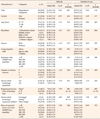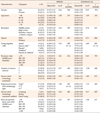Abstract
Purpose
This study aimed to investigate attitude toward and intention to use the so-called silver-care robot technology in older adults and family members.
Methods
This descriptive correlational study recruited 80 older adults and 80 family members who were users of a general hospital in Seoul city. Data collection, conducted from February to March 2019, used the Almere model and self-reported questionnaires that included items on socio-demographic and robot-related characteristics.
Results
The mean age of the older adults was 73.48±6.88 years and that of family members was 53.48±10.08 years. No differences were identified in attitude toward and intention to use silver-care robot technology among the older adults and family members. The older adults were more concerned with the trustworthiness (t=2.46, p=.015) of the care robot technology, whereas the family members were more concerned with ease of use (t=−2.97, p=.003). Intention to use was significantly affected by perceived enjoyment in the older adults (25.4%, p=.001) and perceived usefulness (p=.009) and ease of use (p=.002) in the family members (57.1%).
Figures and Tables
Table 1
Differences in Attitude toward and Intention to Use for Silver-care Robot Technology according to the General Characteristics of the Older Adults (N=80)

Table 2
Differences in Attitude toward and Intention to Use for Silver-care Robot Technology according to the General Characteristics of the Family Members (N=80)

Table 3
Differences in Attitude toward, Intention to Use, and Related Factors for Silver-care Robot Technology between the Older Adults and Family Members (N=160)

Table 4
Correlation among Attitude, Intention to Use, and Related Factors of Silver-Care Robot Technology in Hospitalized Older Adults and Family Members (N=80)

ACKNOWLEDGEMENT
This article is based on a part of the first author's master's thesis from Seoul National University.
References
1. Statistics Korea. 2017 population and housing census press release total collection [Internet]. Daejeon: Statistics Korea;2018. cited 2019 November 8. Available from: http://kostat.go.kr/portal/korea/kor_nw/1/2/2/index.board?bmode=read&bSeq=&aSeq=370326&pageNo=1&rowNum=10&navCount=10&currPg=&searchInfo=&sTarget=title&sTxt.
2. Statistics Korea. Future population special estimation [Internet]. Daejeon: Statistics Korea;2019. cited 2019 September 6. Available from: http://kostat.go.kr/portal/korea/kor_nw/1/1/index.board?bmode=read&bSeq=&aSeq=373873&pageNo=3&rowNum=10&navCount=10&currPg=&searchInfo=srch&sTarget=title&sTxt=%EC%9D%B8%EA%B5%AC.
3. Lee JH. Fourth industrial revolution and changes in elderly care. International Social Security Review. 2019; 2019(summer):141–146.
4. Sharkey A, Sharkey N. Granny and the robots: ethical issues in robot care for the elderly. Ethics and Information Technology. 2012; 14(1):27–40. DOI: 10.1007/s10676-010-9234-6.

5. Robinson H, MacDonald B, Broadbent E. The role of healthcare robots for older people at home: a review. International Journal of Social Robotics. 2014; 6(4):575–591. DOI: 10.1007/s12369-014-0242-2.

6. International Federation of Robotics (IFR). A positioning paper by the international federation of robotics [Internet]. Frankfurt: World Robotics Industrial Robots and Service Robots;2018. cited 2019 April 11. Available from: https://ifr.org/worldrobotics.
7. Ministry of Trade, Industry and energy policy information [Internet]. Sejong: Ministry of Trade Industry and Energy Robot Machinery Division;2019. cited 2019 September 6. Available from: http://www.motie.go.kr/motie/py/fe/robot/robotoutline/robotoutline.jsp.
8. Kim YK. The next big thing service robot trends and implications. ICT Spot Issue. Daejeon: Institute for Information and Communications Technology Promotion;2017. 06. p. 15–38. Report No.: S17-06.
9. Heerink M, Krose B, Evers V, Wielinga B. Assessing acceptance of assistive social agent technology by older adults: the Almere model. International Journal of Social Robotics. 2010; 2(4):361–375. DOI: 10.1007/s12369-010-0068-5.
10. Flandorfer P. Population ageing and socially assistive robots for elderly persons: the importance of sociodemographic factors for user acceptance. International Journal of Population Research. 2012; 2012:1–13. DOI: 10.1155/2012/829835.

11. Ezer N, Fisk AD, Rogers WA. Attitudinal and intentional acceptance of domestic robots by younger and older adults. Berlin: Springer;2009. p. 29–48. DOI: 10.1007/978-3-642-02710-9_5.
12. Loffredo D, Tavakkoli A. What are european union public attitudes towards robots. Systemics Cybernetics and Informatics. 2016; 14(1):11–19.
13. Mitzner TL, Boron JB, Fausset CB, Adams AE, Charness N, Czaja SJ, et al. Older adults talk technology: technology usage and attitudes. Computers in Human Behavior. 2010; 26(6):1710–1721. DOI: 10.1016/j.chb.2010.06.020.

14. Heerink M. Exploring the influence of age, gender, education and computer experience on robot acceptance by older adults. Proceedings of the 6th International Conference on Human-Robot Interaction. 2011; 1:147–148.

15. Lee C, Coughlin JF. Perspective: older adults' adoption of technology: an integrated approach to identifying determinants and barriers. Journal of Product Innovation Management. 2015; 32(5):747–759. DOI: 10.1111/jpim.12176.

16. Pino M, Boulay M, Jouen F, Rigaud AS. “Are we ready for robots that care for us?” attitudes and opinions of older adults toward socially assistive robots. Frontiers in Aging Neuroscience. 2015; 7:141. DOI: 10.3389/fnagi.2015.00141.

17. Joranson N, Pedersen I, Rokstad AMM, Ihlebaek C. Effects on symptoms of agitation and depression in persons with dementia participating in robot-assisted activity: a cluster-randomized controlled trial. Journal of the American Medical Directors Association. 2015; 16(10):867–873. DOI: 10.1016/j.jamda.2015.05.002.

18. Broadbent E, Kuo IH, Lee YI, Rabindran J, Kerse N, Stafford R, et al. Attitudes and reactions to a healthcare robot. Telemedicine and e-Health. 2010; 16(5):608–613. DOI: 10.1089/tmj.2009.0171.

19. Xu Q, Ng J, Tan O, Huang Z, Tay B, Park T. Methodological issues in scenario-based evaluation of human-robot interaction. International Journal of Social Robotics. 2015; 7(2):279–291. DOI: 10.1007/s12369-014-0248-9.

20. Czaja SJ, Charness N, Fisk AD, Hertzog C, Nair SN, Rogers WA, et al. Factors predicting the use of technology: findings from the center for research and education on aging and technology enhancement (create). Psychology and Aging. 2006; 21(2):333–352. DOI: 10.1037/0882-7974.21.2.333.

21. Kim YK, Lee JS, Son SH, Cho SH, Park SA. A study on the change of dual support burden structure and countermeasures of middle-aged families. Research Report. Sejong: Korea Institute for Health and Social Affairs;2018. 12. p. 124–128. Report No.: 2018-14.
22. Kim JS. Korea's retirement life competitiveness, middle rank among 12 major countries [Internet]. Seoul: Maeil Economy;2017. cited 2019 May 14. Available from: https://www.mk.co.kr/news/economy/view/2017/08/576431/.
23. Hancock PA, Billings DR, Schaefer KE, Chen JY, De Visser EJ, Parasuraman R. A meta-analysis of factors affecting trust in human-robot interaction. Human Factors. 2011; 53(5):517–527. DOI: 10.1177/0018720811417254.

24. Han SW. Cognitive aging and acceptance of information and communication technology. Seoul National University Institute of Economics Research. 2017; 56(1):51–60.
25. Heerink M, Krose B, Evers V, Wielinga B. The influence of social presence on acceptance of a companion robot by older people. Journal of Physical Agents. 2008; 2(2):33–40.

26. Cho OS, Kim JI, Kim YM. A study on sleep quality and geriatric depression in the elderly between hospital and senior welfare service center. Journal of the Korean Gerontological Society. 2013; 33(2):493–507.
27. Yoo HJ, Kim SY, Nam HW, No YK, Sin SH, Yoon JR, et al. Geriatrics medicine. 3rd ed. Seoul: The Korean Geriatrics Society;2015. p. 595–598.
28. Robinson H, MacDonald B, Kerse N, Broadbent E. The psychosocial effects of a companion robot: a randomized controlled trial. Journal of the American Medical Directors Association. 2013; 14(9):661–667. DOI: 10.1016/j.jamda.2013.02.007.

29. Martinez-Martin E, Del-Pobil AP. Personal robot assistants for elderly care an overview. Personal Assistants Emerging Computational Technologies. Basel: Springer;2018. p. 77–91.
30. Chae HR. Financial review. Aging society, caring robots evolve [Internet]. Seoul: Financial Review;2019. cited 2019 June 1. Available from: http://www.financialreview.co.kr/news/articleView.html?idxno=16693.
31. Park HJ, Jung BR, Kim OH, Kim YK, Ahn HJ, Lee YN, et al. Experience on emotional support of hospital nurses. Korean Journal of Adult Nursing. 2008; 20(6):852–865.
32. Hong ST, Shin JC, Kang MS. A study on the factors affecting the acceptance intention of intelligent robot service for home use-application of technology acceptance model and innovation diffusion model. Korean Journal of Marketing. 2008; 9(4):271–303.
33. Choi MY, Kim SI. A study on the role of social robots in user experience. Journal of Digital Convergence. 2017; 15(2):295–300. DOI: 10.14400/JDC.2017.15.2.295.




 PDF
PDF ePub
ePub Citation
Citation Print
Print




 XML Download
XML Download